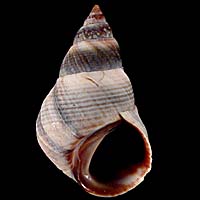|
< Previous family introduction |
|
|||||
 |
Family Littorinidae Periwinkles
|
|||||
|
The family Littorinidae consists of about 180 species, is of worldwide distribution, and is well known as the winkles or periwinkles of Europe, where several species are eaten. Littorinids are common or abundant members of the upper intertidal zone on rocky shores, where they graze on algal films or macroscopic algae. Many of them are very tolerant to exposure, living around the high tide mark with only brief periods of immersion. In NSW, littorinids live in a variety of habitats, but the most obvious occur in the upper intertidal zone of rocky shores. The small blue periwinkle Austrolittorina unifasciata is abundant on the most exposed and semi-exposed rocky shores in southern Australia. The larger species Nodilittorina pyramidalis is less abundant, but can occur up to 10 metres above high tide level where spray from strong wave action occurs. These high tidal species feed on the thin film of algae on the rock, and reproduce by depositing eggs in capsules in cracks and crevices. Larvae hatch from the eggs and are washed into the sea, from where they eventually settle onto some near or distant rocky shore. As well as rocky shores, littorinids also occur in more sheltered habitats in NSW. Mangrove forests are the habitat of the genus Littoraria, where members live on trunks and leaves, often metres above high tide level. They feed on the fine film of algae, epiphytic growths and leaf hairs of the mangroves. At a lower level in the mangroves, Bembicium auratum lives on roots, rocks and oysters. The Littorinidae is one of the best studied families of molluscs in Australia, both taxonomically and ecologically. The work of Dr David Reid of the British Museum has been revolutionary in developing an understanding of the family at the species and at the higher taxonomic level. As a result of his work, of the 13 species of the family listed in Iredale & McMichael's 1962 checklist of NSW molluscs, only five are now known by the same species name as they were then, and only two are placed in the same genus. Work on intertidal ecology by Dr Tony Underwood and his group at Sydney University has included studies of littorinids, providing an understanding of their reproductive cycles, recruitment, growth, longevity, habitats, population structure and dynamics, food, predators, ecology and life history. This work recognizes 11 species of littorinids in NSW. Eight of these have distributions restricted to eastern Australia or to eastern and southern Australia. The remaining three species belong to the genus Littoraria, which occurs in mangroves throughout the tropical Indo-West Pacific; the one common species in NSW is restricted to eastern Australia, and the other two occur in the central Indo-West Pacific. Family References
Coverage All species of Littorinidae that occur in NSW are detailed here. Identification Notes Shells of the Littorinidae encompass a variety of shapes, and have no combination of characters which can be used to uniquely place them into the family. Shells vary from 2-30 mm in length in NSW. They are usually spirally grooved but sometimes spinose, have the aperture entire and lack an umbilicus, but these characters are common to many families. The large species are quite easy to identify because they are among the most abundant animals high on the shore, but the minute species are difficult to separate from several other families. |